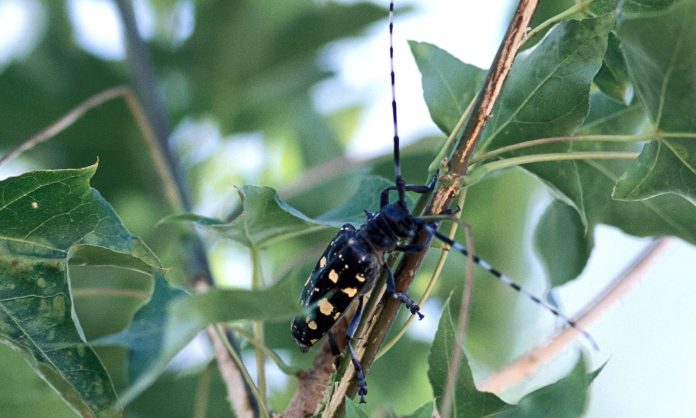CLERMONT COUNTY, Ohio — The Asian Longhorned Beetle quarantine has been lifted in parts of East Fork State Park and its campground, a sign of progress in the overall eradication process.
The Ohio Department of Agriculture, Ohio Department of Natural Resources and U.S. Department of Agriculture held a joint press conference April 15 at the East Fork State Park north shore boat ramp to announce the milestone.
The department of agriculture’s eradication program surveyed more than 66,000 trees, performed multiple rounds of campground surveys, and conducted in-person outreach for continued education on the beetle. With the cooperation from the local community and support from government partnerships, 7.5 square miles of East Fork State Park just north of the lake have been deregulated.
This declaration lifts certain restrictions, including the movement of firewood out of the campground.
The Asian Longhorned Beetle can cause serious damage to Ohio’s trees. The adults emerge from the trees throughout the summer, with the chances of seeing adult beetles peaking in August. Checking trees for the beetle and damage it causes is one-way residents can protect their own trees and help the efforts to eliminate this invasive beetle from the United States.
The quarantine remains in place for Tate Township and other areas in East Fork State Park, including the East Fork State Park Wildlife Area. The beetle was first discovered in Tate Township, Clermont County in June 2011. Since then, over 112,000 trees have been removed to stop the spread of this pest in Ohio.
The beetle is an invasive, wood-boring beetle that attacks 12 types of hardwood trees in Ohio, such as maples, elms, birches, willows and Ohio’s official state tree, the buckeye. The beetle creates tunnels as it feeds then chews its way out as an adult in the warmer months, typically around August.
Infested trees do not recover, eventually, die, and can become safety hazards since their weakened branches can drop and trees can fall over, especially during storms.
The beetle has bright and distinctive markings that are easy to recognize, including black and white antennae that are longer than the beetle’s body, a shiny black body with white spots that is about 1-inch to 1.5-inches long and six legs and feet that can appear bluish in color.
Signs that a tree might be infested include round exit holes in tree trunks and branches, about the size of a dime or smaller and shallow oval or round scars in the bark where the adult beetle chewed an egg site. There may also be sawdust-like material, called frass, on the branches or ground around the tree and dead branches or limbs falling from an otherwise healthy-looking tree.
This invasive beetle poses a great threat to Ohio’s hardwood forests (more than $2.5 billion in standing maple timber) and the state’s $5 billion nursery industry, which employs nearly 240,000 people.
If you think you’ve seen the beetle or signs of infestation, contact the Ohio ALB eradication program office at 513-381-7180 or email alb@agri.ohio.gov. If possible, capture the insect, place it in a jar and freeze it for identification. If you have a camera, take photos of the insect and the damage to your trees.










